On the Austrian Way of St James, on the route between Ulm and Constance, in Vienna, in South Tyrol and in Switzerland, I have repeatedly encountered the "Mariahilfbild" in the
form of a copy.
The original by Lucas Cranach the Elder is on the high altar of St Jacob's Cathedral in Innsbruck.

The picture makes a very harmonious impression, evoked by the arrangement of the figures in the triangle, but above all by the facial expression, which expresses the happiness and contentment of the mother-child relationship.
Mary is not looking at the baby Jesus but at the viewer. She presents the baby Jesus with restrained modesty. She holds him very close to her. Her hands embrace the child and offer him security. Their cheeks touch. The child turns to his mother, seeking protection and caressing her.
At the same time, the picture conveys the tenderness and love with which Mary holds the child and which the child reciprocates.
Nothing disturbs the idyll. No ornamentation, no angels, no clouds, no grapes or other symbols. And above all, no crowns. Mary is a completely normal woman. She is not depicted as the Queen of Heaven. Many, especially baroque copyists, did not understand this and put crowns on the baby Jesus and Mary.
Maria shows us the fashion of the Renaissance period. The sleeves of her costume are remarkable.
The painting was created between 1517 and 1525, i.e. during the Reformation. Lucas Cranach was a close friend of Martin Luther. We see a new "reformed" Mary. This Protestant painting became the most widespread image of the Virgin Mary in the Catholic world of the Alpine region and southern Germany. The original and certain copies are venerated as having miraculous powers.
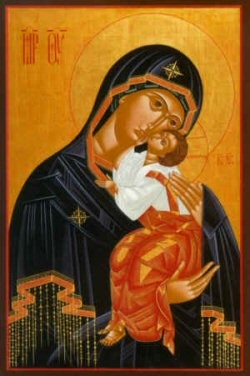
Possible role models
In the literature on Cranach's Mariahilfbild one often reads about Byzantine models.
In Byzantine culture, the "ElŽusa" type of mother goddess emerged as early as the 1st millennium. ElŽusa means something like "mother of compassion". The child turns to its mother, seeking protection and caressing her. Mary, however, looks over the child into the distance. The mother's hands embrace her child, but the seriousness of her gaze reveals that she is aware of Christ's future fate.

The Italian painter Raphael created countless "Madonna and Child" paintings. This sketch with a very similar head and hand position was created before Cranach's Mariahilf painting.
I don't think Cranach used a model. The Mariahilfbild is the culmination of an evolutionary development of his Madonna and Child depictions under the influence of his friend Martin Luther.
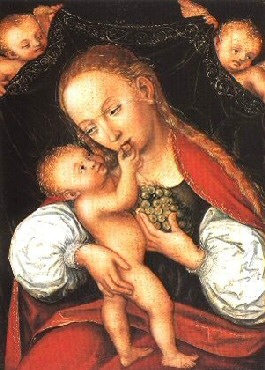
Lucas Cranach painted the Madonna and Child motif dozens of times. In my opinion, the most similar paintings are
Madonna with the bunch of grapes, museum in the Wartburg ...

... and this Madonna and Child with a romantic background.
The style of this early Cranach painting may have been influenced by the "Danube School" or by his encounter with DŁrer.
The posture of the head, the position of the eyes, the ears, the mouth and the arrangement of the hair suggest a Madonna template.
Who modelled for Maria?
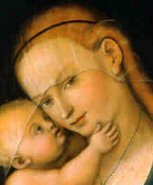
Maria
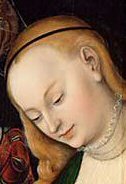
Servant
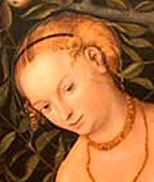
Caritas

Who did Cranach use as a model for Mary? Is it his personal idea of Mary, an ideal woman, or his own wife Barbara when she was young?
This woman's head appears for the first time in the painting Judith and Holofernes. It is the servant who happens to be in the picture, but has nothing to do with the story. Let us compare Judith's young servant with a picture of the older Barbara Cranach. He immortalised her on the Reformation altar in Wittenberg.
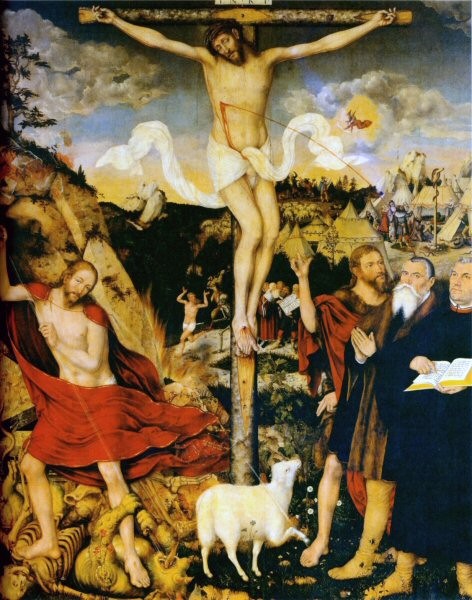
Cranach also depicted family members in other paintings who have nothing to do with history. For example, he himself stands next to his friend Martin Luther under the crucified Christ (altarpiece in the Herder Church in Weimar.
The shape of the woman's head and posture, the hairstyle, the headband and the earlobe are similar. The head of his "Caritas" also bears a strong resemblance to that of Mary. All these heads in the same tilted position probably originate from a Cranach "Madonna stencil".

Judith with the head of Holofernes and servant

The seated Caritas
Mary's veil has driven many a copyist to despair. Painting a transparent veil requires a special painting technique that Lucas Cranach mastered. Many of his female figures wear transparent veils, such as Caritas or Judith.
There are many copies of the Mariahilf picture in Europe. I have photographed some of them and placed them in a Maria Hilf picture collection. See there!
Links to the Mariahilf picture: http://www.kirchenundkapellen.de/kirchenpz/Passauermariahilfbild.htm
The parish of Sulz im Wienerwald describes on its website the history of the Mariahilf picture